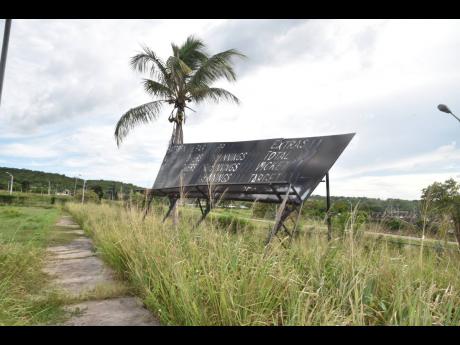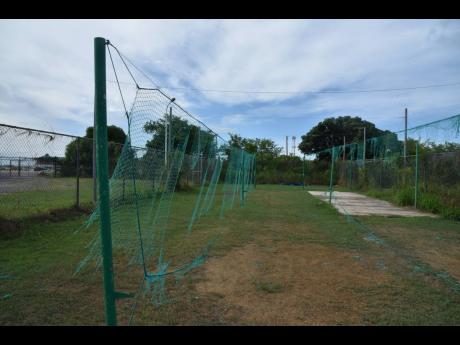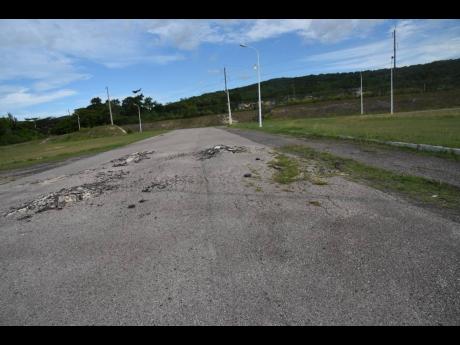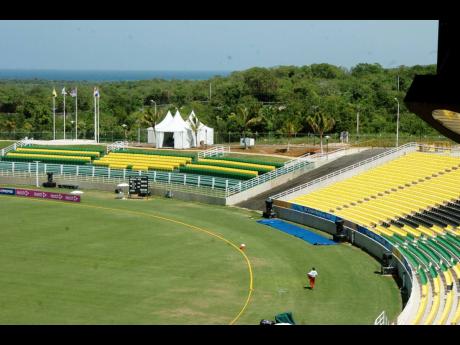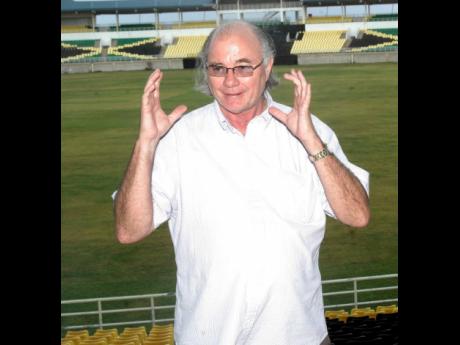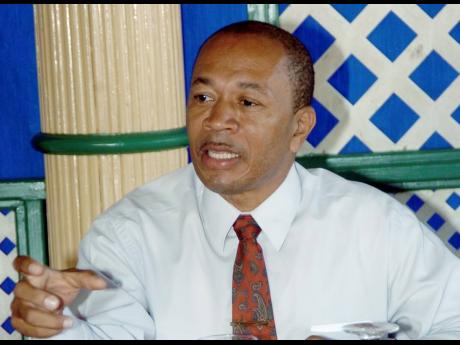From gold spoon to white elephant
Trelawny Multipurpose Stadium: A multibillion-dollar story of neglect
Sixteen years after hosting the opening ceremony for the 2007 ICC Cricket World Cup, the Trelawny Multipurpose Stadium in Florence Hall, Trelawny, is in ruins. Bringing in little or no revenue to the government coffers, today the facility is a...
Sixteen years after hosting the opening ceremony for the 2007 ICC Cricket World Cup, the Trelawny Multipurpose Stadium in Florence Hall, Trelawny, is in ruins.
Bringing in little or no revenue to the government coffers, today the facility is a burden on taxpayers, costing over $60 million annually to maintain.
The multipurpose facility was constructed in 2007, with a loan of some US$30 million from China, to host the World Cup. The loan terms dictated that the money be repaid over a 20-year period and attracted an interest rate of two per cent per annum.
The facility, which was built by Chinese firm COMPLANT and is operated by Independence Park Limited, hosted the opening ceremony and four warm-up matches for the 2007 Cricket World Cup. Since then, only select religious and entertainment events, a handful of competitive cricket matches, and a few football games have graced its grounds.
In 2010, the Trelawny Stadium became the new home of the Jamaica Jazz & Blues Festival, but when the international event “took a break” in 2016, it left a major dent in earnings for the complex.
“Us leaving had nothing to do with the stadium; the facilities were fantastic,” Walter Elmore, CEO of Turnkey Promotions, the organisers of the Jamaica Jazz & Blues Festival, told The Sunday Gleaner.
“I took the decision to shift from where we were at the Aqueduct after the prime minister had to walk to his hotel because of traffic, and the Trelawny stadium was the ideal choice, but I have not been there since we stopped Jazz and Blues, so it would be unfair to comment on the status of it now,” he stated from his home overseas.
Elmore revealed that he would be coming to Jamaica this month, during which he would be meeting with key government officials and touring the Trelawny stadium, but he declined to reveal if he is planning a return there with the festival.
FLEETING NATURE OF GLORY … CONSEQUENCES OF NEGLECT
When The Sunday Gleaner visited the Trelawny Multipurpose Stadium earlier this month, the news team was reminded of the fleeting nature of glory and the consequences of neglect.
The memories of the excitement of one particularly special night, when Jamaica showcased the vibes and the sounds of the Caribbean people on March 11, 2007, have been replaced by abandonment and decay.
Sections of the roadway approaching the ticketing booth are eroding, while vines and weeds have taken over the once-immaculate landscape, penetrating the hard surface of the parking lots. Wires hang loosely from utility poles, and the fading paint on the walls seems to contradict the teenage years of the stadium.
The ticket booths betray years of inactivity, as do the creaking turnstiles, their mechanisms rusted and barely functional.
Inside the facility, which in its early days was known as the Greenfield Stadium, most of the seats are intact, though a few have cracks and most are weather-beaten. The playing field is a bed of dead grass and weeds, with a closer examination showing large areas of the turf completely bare.
The scoreboard is toppling over, and the play area is surrounded by lush unkempt greenery. Wires from electrical circuits hang about loosely, and the practice nets for the cricketers are in shreds.
As The Sunday Gleaner team walked through the facility, the hollowness was occasionally interrupted by a whoosh of wind from the nearby Caribbean Sea and voices from happenings at the entertainment company that operates at the rear of the North Stand.
MULTIMILLION-DOLLAR BUDGET ITEM
According to the 2023-2024 Estimates of Expenditure, the Trelawny Multipurpose Stadium received $63.735 million of taxpayers’ money, $26.282 million of which was allocated to offset operating expenses, despite its current non-productive state.
Some $64.083 million was allocated to support the stadium’s operations the previous fiscal year, of which $21.949 million was earmarked to offset operational costs – a few hundred dollars less than the allocation for the 2021-2022 period.
Major Desmon Brown, chief executive officer of Independence Park Limited, which manages both the National and Trelawny stadiums, acknowledged receiving several questions sent by The Sunday Gleaner about the facility, but referred the news team to his boss, Sports Minister Olivia Grange.
Up to press time, there was no response from the ministry to queries sent by The Sunday Gleaner two weeks ago.
Falmouth Mayor Councillor Collen Gager admitted that the Trelawny Municipal Corporation is responsible for collecting the fees for the use of the facility, but referred our news team to Grange’s ministry and the Independence Park team, who he said had ultimate responsibility.
TRELAWNY GETS NOD OVER SABINA
In 2004, Sabina Park and the National Stadium in Kingston, as well as the construction of the stadium in Trelawny, were the three recommendations put to the P.J. Patterson-led government to host the 2007 Cricket World Cup matches by Jamaica’s Bid Committee.
Sabina Park was the committee’s first choice, despite its limited scope for further development. In order to be a suitable venue, it would have had to increase its capacity by more than 100 per cent, which would have been a costly undertaking.
There was also the challenge of catering, as well as concerns about adequate accommodation, parking and transportation.
This became a vexing issue between the Sabina group and lobbyists from western Jamaica operating under the name ‘The Trelawny Group’, who championed the need to construct a facility that could subsequently host international Test cricket and one-day matches for years to come.
“We are projecting the [year-round] use of the Greenfield Stadium. We propose the setting up of a marketing company that can bring international events to us, and we have proposed a sports tourism complex,” said former government minister Desmond Leakey, head of the Trelawny Group at the time.
Eventually, the Trelawny Stadium project got the nod over Sabina Park to host the 16 countries, officials, an estimated 20,000 spectators, and over 2,000 media personnel at the March 2007 opening ceremony.
Those opposing the construction of the Trelawny complex warned that it would be a waste of money, as the facility would be underutilised.
But Patterson sought to downplay concerns that the facility would become a white elephant post-Cricket World Cup when he revealed during the 2005 groundbreaking ceremony that a company was already engaged to assume ownership after the cricketing spectacle.
SHORTSIGHTEDNESS A BIG PROBLEM
“What makes the issue of the Trelawny Stadium almost tragic is that it was touted from the beginning that this stadium would only become a white elephant, and many sports-loving Jamaicans felt that rehabilitating every other cricket ground in Jamaica would have been money better spent,” popular sportscaster Orville Higgins shared with The Sunday Gleaner.
“I have been there a few times. It is run-down, almost unkempt, looks almost unsupervised, and a waste of well-needed resources.”
He continued, “This facility is at a prime location in Jamaica and if they had a vision for that place, it could be even more valuable than the National Stadium because that section of our country is ideal for sports tourism, but as it is now, you cannot help but wonder if that massive expense to build it wasn’t a complete waste of time.”
Dr Patrick Harris was member of parliament for Trelawny Northern, where the stadium is located, from 2002 to 2011. He admits that there were some missteps, but claims that advanced talks were held for the professional management of the facility.
“The rationale for the stadium being built in Trelawny and western Jamaica was because the alternative was a private venue in Kingston [for the Cricket World Cup] that the Government would have had to pay for,” Harris, a medical doctor by profession, told The Sunday Gleaner.
“The Government would not want to put $50 million into private hands when it could be placed for public use while upgrading the other facility in Kingston for the event.”
Harris said that there was a development plan in place – to build a cricket stadium and then add features for other disciplines after the World Cup. The government of the day also upgraded the hospital and the fire station, and built a new state-of-the-art police station in the nearby parish capital, he said.
“The infrastructure was in place, but what was left was the management of the facility, and that is where we fell down big time,” he said.
“Jamaica needs professionals to manage the sports industry and we did have those people at the table. They wanted to build hotels and another wanted to combine the hotel project with the stadium. We also had overseas teams, particularly from North America, enquiring to use the facility for practice matches.”
Harris continued, “But the leaders of the day, during my time, never knew that they needed to drop the parochial hat that they wore and look at other areas as well. As a people, we cannot continue to be myopic in the selection of projects. We cannot continue to look at projects narrowly. There is such a big economic windfall to be had from sports.”
“What we needed in short order was that a management team be set up that had nothing to do with politics, just strictly business,” he added. “We had a gold spoon in our mouth but made a fool of the opportunity because of want of management. What we need are knowledgeable individuals in the sporting sector to guide the process because Falmouth is infrastructure-ready.”
UTECH’S REJECTED BID TO TAKE OVER FACILITY
Trelawny businessman Dennis Meadows, the People’s National Party’s (PNP) caretaker for Northern Trelawny, believes the Trelawny Multipurpose Stadium should be leased to the University of Technology, Jamaica (UTech) or another educational institution.
After the Bruce Golding government took over from the Portia Simpson Miller administration in September 2007, UTech had made a bid to use the stadium as an education and sporting facility, which was endorsed by a number of businessmen and politicians in Trelawny. However, the Government did not accept the proposal.
“The failure to adequately use the Trelawny Stadium is a tragedy of inaction and poor decision on the part of the Government,” Meadows told The Sunday Gleaner.
“Some time in 2007, the University of Technology, under Professor Errol Morrison and supported by the late businessman and philanthropist Tony Hart, made an earnest effort to lease the stadium with a view to making it its main western campus.”
“Unfortunately, UTech failed in its bid, as the Government, through its minister of sport, rejected the proposal, and I think that was a tragic decision on the part of Minister Grange,” added Meadows, who has been calling for the historic seaport parish capital to be developed into a university town.
In UTech’s proposal to the Government, Morrison described the need to expand the school’s student population as an urgent matter.
This was needed, he said, to improve the school’s financing to meet its new status as an independent university and a corresponding reduction in its subsidy from the Government. Morrison said the school’s objective was to develop a full university campus in western Jamaica.
However, UTech’s proposal faced competition from the United States-based National Basketball Association and Major League Baseball, which the Government believed would prove to be a significant source of foreign exchange for the country.
Morrison also argued that the acquisition of the stadium would lend importance to the major developmental role the university intended to lead in the areas of sports and sports tourism, and was willing to make the facility available for national and international sporting events, entertainment, and cultural activities.
If approved, he said, the university would have started with the rooming provisions currently at the facility and then gradually build out on adjacent lands.
The professor also sought to assure the Government that UTech Jamaica West would not interfere with or duplicate the Urban Development Corporation’s proposal for a mega-sports complex at Caymanas in St Catherine.
But in a letter dated July 15, 2009, Golding told Morrison, “A decision on the future of the Trelawny facility will only be made after careful consideration of a number of issues, including the financial liabilities incurred by its establishment, which must be discharged, and the demand for sports and entertainment facilities in western Jamaica for which the stadium was constructed.”
NO WORD ON USAIN BOLT SPORTS ACADEMY
When contacted to determine if UTech still had an interest in the Trelawny stadium, Hector Wheeler, associate vice president for advancement at the university, opted to allow the new president, aerospace engineer Dr Kevin Brown, who was scheduled to take office last week, to comment.
Wheeler did, however, note that, “It would be best to see where our interest is now because we have had different administrative leads since then and there have been shifts in focus. What I can say is that we had a strong interest and an approach was made to a previous administration, but I cannot say it was a rejection from the Government.”
In 2015, after Simpson Miller returned to power, it was announced that the facility would be renamed the Usain Bolt Sports Academy in honour of the Trelawny-born sprint icon. But there has been no further word to date on those plans.
With an uncertain future, the Trelawny Multipurpose Stadium stands as a ghostly monument to a time when it pulsed with life and energy. Yet, although weathered and weary, some still hope for the tender touch of restoration. Or for the less hopeful, the final embrace of time’s unforgiving hand.

